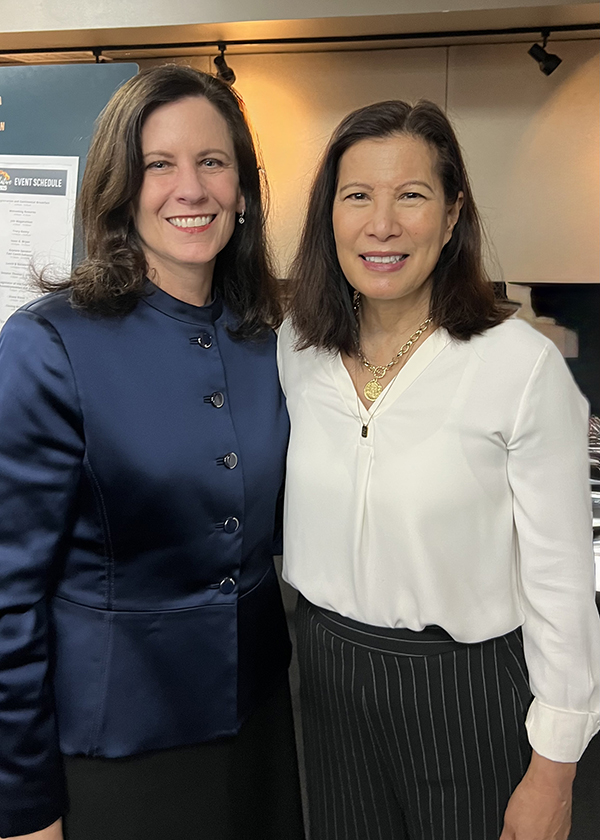California Lawyers Association
Lawyers are Warriors in the World of Justice
May 2025
By Betty Williams
CLA President

As we celebrate Asian American and Pacific Islander (AAPI) Heritage Month, it is important to recognize and celebrate the contributions of Asian, Native Hawaiian, and Pacific Islander Americans to our profession.
Bar Number 2326 belonged to Chan Chung Wing, the first Chinese American lawyer in California. Wing attended USF School of Law in the evening, after working for A.P. Giannini, the founder of the Bank of Italy (today, “B of A”). During his tenure at the Bank of Italy, Wing observed Chinese merchants being denied life insurance because of a belief that Chinese people were a bad risk due to their dietary choices of fish heads and rice. Wing started the C.C. Wing Agency, reputed to be the first Chinese life insurance agency in California, which later became one of Occidental Life Insurance Company’s top producing agencies in the 1940s, 1950s, and 1960s.
Wing’s instrumental work in the banking and insurance industries tell just a small part of his story. After being admitted to practice in 1918, he faced the refusal of judges to allow him to practice in court. When he was allowed to practice, Wing became accustomed to losing cases at the trial court level in San Francisco. Ultimately though, he would generally prevail on appeal, notably in a case involving a Chinese man accused of murdering his employer.
It would be 20 years later in 1938 when the first Japanese American female became a lawyer in California. Chiyoko Sakamoto (Takahashi) was admitted to practice after graduating from the American University Washington College of Law in Los Angeles, California. Shortly thereafter, during World War II, Sakamoto was imprisoned in the Granada Internment Camp. She was not released until 1947; she then went to work for a small law firm in Los Angeles before opening her own firm. Sakamoto was one of the founders of the Japanese American Bar Association and the California Women’s Bar.
Progress can be slow; another 34 years passed before Eleanor Nisperos became the first Filipino American female lawyer in California.
Turning to the judiciary, John Aiso was the first AAPI judge appointed to a California trial court in 1953, Los Angeles Municipal Court. He succeeded ultimately to serve the California Court of Appeal, Second Appellate District. Born in Burbank, California in 1909, Aiso faced discrimination throughout his childhood. He earned his degree from Harvard Law School in 1934 and was drafted into the U.S. Army in 1941, where he eventually became the highest ranking Japanese American in the U.S. Army during World War II.
California did not elect or appoint its first female AAPI judges until the 1970s and in some courts, well into the 21st century. Patricia Yim Cowett became the first Chinese American female judge in California in 1979, Lillian Lim was the first Filipino American female judge in California in 1986, and in 2011, Tani Cantil-Sakauye became the first Asian-Filipino American female to serve as the Chief Justice of the California Supreme Court.
Even today we see “firsts” in diverse leadership including in our AAPI community. In 2021, David Chiu became San Francisco’s first AAPI City Attorney and Rob Bonta became the first known Filipino-American to serve as California’s Attorney General.
Many of those who were “first” to achieve these remarkable accomplishments did so with great obstacles to overcome. They were persistent and determined.
Today, 17.5% of California’s adult population identifies as AAPI[1], with 14.4% of our lawyers[2] and 11.4% of our judges[3] indicating AAPI as their ethnicity, thanks to the bold and brave work of the first AAPI attorneys and judges in our states, and the ongoing efforts by our diverse bar associations, practitioners, and educators.
“Lawyers are warriors in the world of justice,” said former California Chief Justice, Tani Cantil-Sakauye, at CLA’s recent Legislation Day.
We know it is the job of lawyers to represent clients in legal matters, provide legal advice, and advocate for clients in settlement negotiations and in court. Our former chief justice reminded us that when she was on the bench, she saw our advocacy in our closing arguments, whether in writing or in court.
After closing, a matter is out of our hands and submitted to the responding party, or in litigation matters, the court. We count on the judicial branch of the government to correctly interpret the law and reach the right decisions.
The partnership between the bar and the bench is longstanding. Our AAPI leaders have a rich history in the fight for justice. As an attorney, I am grateful to all of the warriors in the legal profession for continuing to advocate for the rule of law and a fair and equitable judicial system.
[1] Statistics as of 2023 according to the Annie E. Casie Foundation.
[2] Data published by the State Bar of California for 2022 as reported by the Annie E. Casie Foundation.
[3] Reported by Judicial Council/California Courts 2024.
